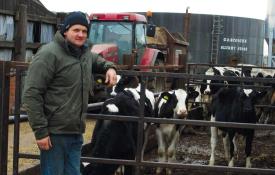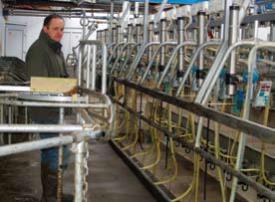
Name: Peter & Jane Chapman
Region: Thornton, Middlesborough
Farm: Mixed Dairy & Arable
Size: 167 hectares
Background:
Peter and Jane Chapman are tenants on Thornton Grange Farm. Most of the land lies within one block in the village of Thornton with a further 15ha some 3km away on the other side of the A174. The main enterprises are a dairy herd and winter wheat (typical yields are nine tonnes per ha). The farm has 94.5ha of grassland, 64.5ha of wheat and 8ha of forage maize. 5ha of rough grassland are only grazed in the summer (by dry cows).
The farm has 175 Holstein cows and 105 followers (30 new born calves and 75 over 6 months old). The herd is calved all year round in cubicles on paper 'envirobeds'. The young stock and 15 of the cows are housed in straw-bedded yards. The cows are housed from October to late April/May, and continue to be barrier fed through the summer. The farm uses contractors for slurry spreading and for baling, but has its own combine. Peter seeks advice from an independent agronomist and nutritionist as required.
What does your nutrient management plan consist of?
Four years ago, Peter was encouraged to arrange a soil analysis after attending an ATB/ADAS arable day. He found that the nutrient content of the organic manures he was applying meant he could reduce inorganic fertiliser inputs and still maintain his yields.
A contractor spreads slurry every 3 weeks using a tanker or an umbilical system to surface spread (a shoe is used near housing in the village to reduce odour). Solid farmyard manure (FYM) is spread onto wheat stubble or onto maize land pre-ploughing. The farm has a low volume electric irrigation system used to spread dirty water. No manures or other organic waster are brought onto the farm.
The organic manure produced by the dairy herd has a significant nutrient content. Cow slurry analysed contained 5.74 per cent dry matter (DM), total nitrogen 6.35kg/tonne DM, total phosphorous 0.58 kg/tonne DM and total potassium 2.41 kg/tonne DM. Based on fertiliser prices at the time, its value was £9,151/year.
What other factors affect your nutrient decisions?

The farms rolling annual application limits to comply with the NVZ regulations and the Code of Good Agricultural Practice (CoGAP) are 81m3/ha dairy slurry (6 per cent DM) and 42.5 tonnes/ha cattle FYM.
What are the benefits?
Considerable savings in artificial fertiliser costs are possible at Thornton Grange Farm if the contribution made by organic manures is taken into account by using a nutrient planning tool. At the time of study, these manures had a value of around £9,150/year.
If fertiliser prices rise still further, there will be even more opportunity for accurate planning of fertiliser application and exploiting use of organic manures to maximise yield potential.